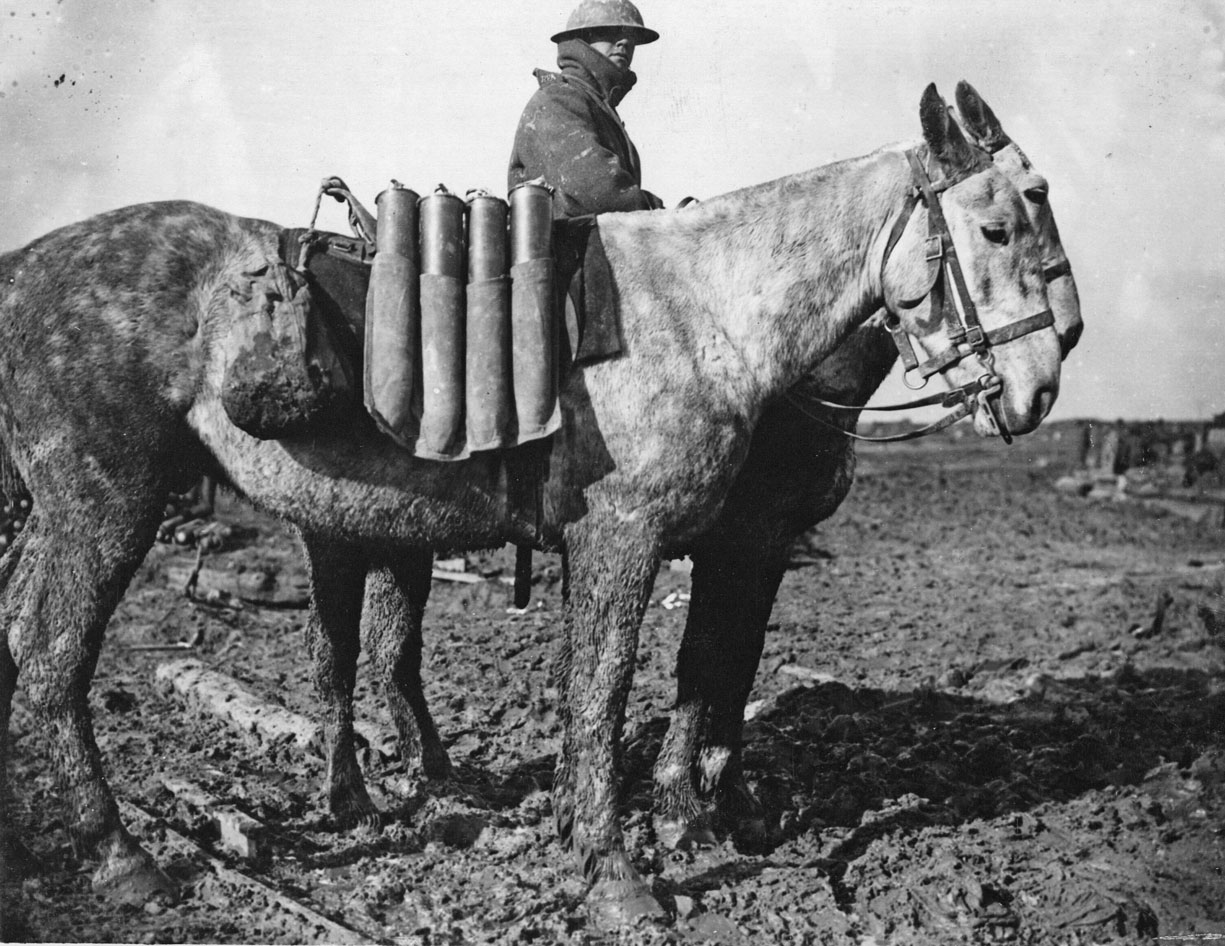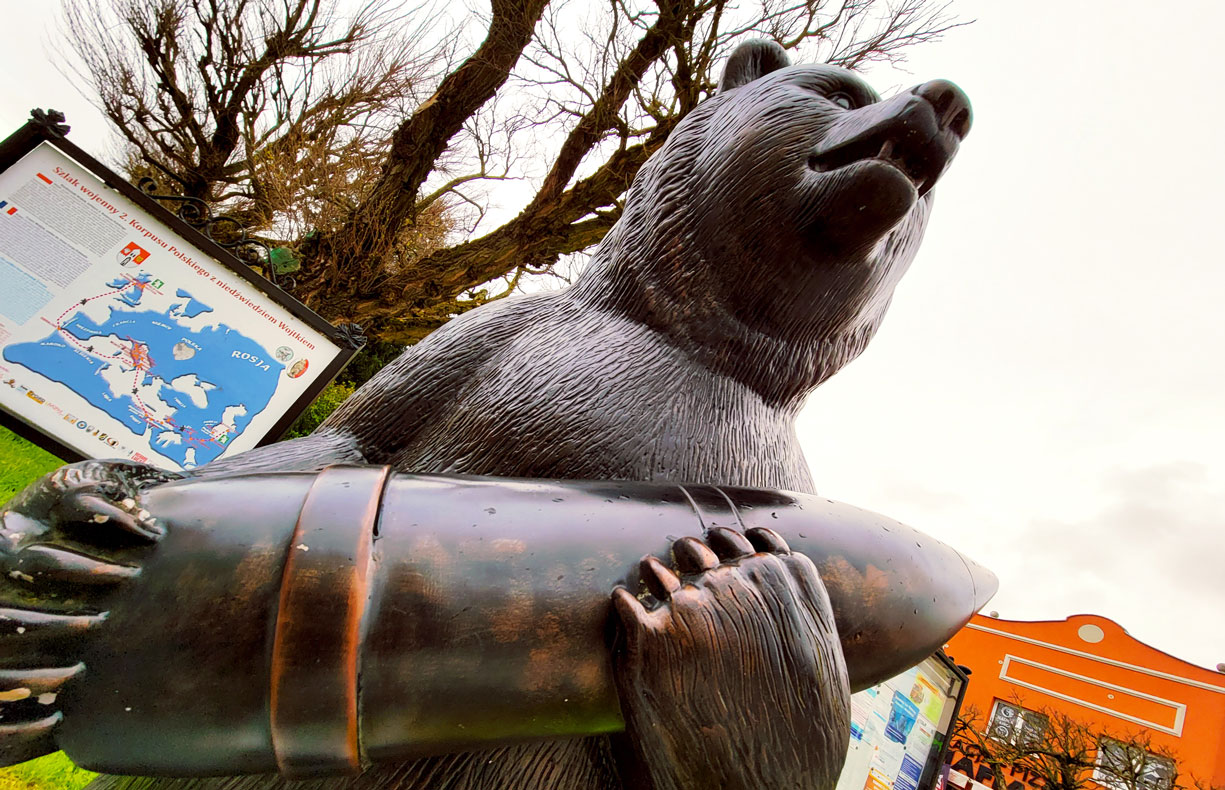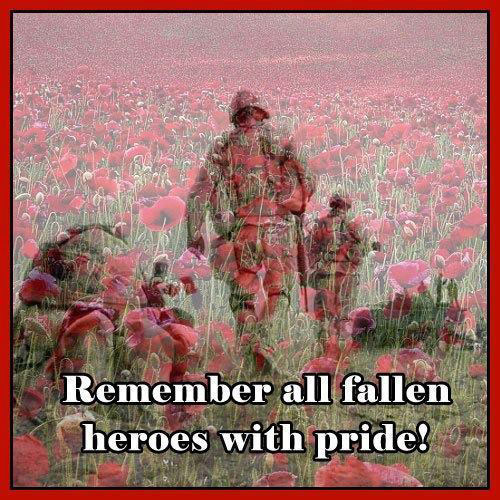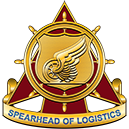U.S. and Poland continue heritage of rapidly moving troops, ammunition for combat readiness
By Story by Sgt. 1st Class Chad Menegay, 1st Armored Brigade Combat Team, 1st Cavalry Division
07.29.2021

U.S. Army muleskinners drove mules up and down the tactically difficult contours of Italy’s Apennine Mountains in World War II, , trudging through marsh flats and over the brittle, loose rock of mountain banks to resupply infantry, field artillery and armor units Jan. 17 to May 18, 1944 during the four battles of Monte Cassino. Today, units like the 115th Brigade Support Battalion “Muleskinners,” 1st Armored Brigade Combat Team, 1st Cavalry Division, which worked out of a Polish Army base in Skwierzyna, Poland, develop relationships with and collaborate with partner forces while conducting training exercises as part of a continued set of rotational U.S. forces in Europe called Atlantic Resolve. (United Kingdom Archive courtesy photo)
U.S. Army muleskinners have once again resupplied troops and armored vehicles in defense of European regional threats.
In World War II, U.S. Army muleskinners drove mules up and down the tactically difficult contours of Italy’s Apennine Mountains, trudging through marsh flats and over the brittle, loose rock of mountain banks to resupply infantry, field artillery and armor units Jan. 17 to May 18, 1944 during the four battles of Monte Cassino.
“All armies had to use pack mules for resupply, and that's how they got the wounded down,” said Harold E. Raugh, Jr., Ph.D., command historian for U.S. Army Europe and Africa. “Can you imagine that, having half your guts blown off, and they strap you to a pack mule to get you down, to evacuate you? That was a tough, tough campaign.”
U.S. II Corps and Polish II Corps under U.S. Fifth Army and British Eighth Army, respectively, took part in an Allied assault on German strongholds May 11, 1944 across two separate fronts of the Gustav Line, which stretched across the Italian peninsula, as part of Operation Diadem, culminating in the fourth and final battle in the greater Battle of Monte Cassino.
The Poles are credited with capturing the ruined abbey atop Mount Cassino on the morning of May 18, hoisting the Polish flag to claim an Allied victory, effectively breaking German defenses on the Gustav Line and opening up the Liri Valley of central Italy— the main route to winning Rome.
Operation Diadem, then, can be seen as one early example of U.S. and Polish forces responsively working toward a common goal as partner militaries.
“YOU LOOK LIKE...A MULESKINNER! LIEUTENANT, IT'S AMAZING HOW I CAN GUESS THE PROFESSION OF A MAN JUST BY LOOKING AT HIM! NOTICE THE BANDY LEGS, THE POWERFUL ARMS. THIS MAN HAS SPENT YEARS WITH MULES." -Richard Mulligan as General Custer in “Little Big Man”
One current example of this U.S. and Polish partnership in combat responsiveness is Atlantic Resolve, a set of rotational U.S. forces throughout Europe. As regional security in Europe continues to be a top priority for the U.S. Atlantic Resolve builds readiness, increases interoperability and enhances the bond between ally and partner militaries using multinational training events.
Units deployed in support of Atlantic Resolve like the 115th Brigade Support Battalion “Muleskinners,” 1st Armored Brigade Combat Team, 1st Cavalry Division, which worked out of a Polish Army base in Skwierzyna, Poland, develop relationships with and collaborate with partner forces while conducting training exercises.
The 115th was recently part of the seventh rotation of an armored brigade combat team in support of Atlantic Resolve and is readying to finish redeployment from Poland.
The “Muleskinners” battalion was responsible for supplying Paladins, Abrams tanks, Bradley Infantry Fighting Vehicles, various other tracked vehicles and wheeled vehicles with munitions for training exercises in the European theater to deter potential adversaries as part of Atlantic Resolve.
A NEARBY ARTILLERY UNIT OPENED FIRE. WE WENT TO LOOK AND FOUND A BATTERY OF POLISH GUNNERS SETTING UP FOR A BARRAGE. THE GUN SIGHT WAS HIDDEN IN A CLEARING WITHIN A LARGE WOOD, AS WE WATCHED SUDDENLY OUT OF THE WOOD CAME A LARGE BEAR WALKING ON ITS HIND LEGS. IT SEEMED TO BE CARRYING SOMETHING. THE BEAR WENT UP TO THE TRAIL LEGS OF THE ARTILLERY GUN AND PLACED A SHELL ON THE GROUND. THE BEAR THEN WENT BACK INTO THE WOOD AND REAPPEARED WITH ANOTHER SHELL. BY THIS TIME WE REALIZED THE BEAR WAS TAME AND MOST LIKELY A CIRCUS BEAR." -John Clarke, Scottish infantryman on The Battle of Monte Cassino

Wojtek the bear, a 500-plus-pound Syrian brown bear that was adopted by the 22nd Transport Company’s Artillery Division, Polish 2nd Corps and served as a morale booster to troops during World War II, is said to have carried artillery shells in the Battle of Monte Cassino, Italy. A statue of Wojtek stands in the town square of Żagań, Poland. U.S. II Corps and Polish II Corps under U.S. Fifth Army and British Eighth Army, respectively, took part in an Allied assault on German strongholds May 11, 1944 across two separate fronts of the Gustav Line as part of Operation Diadem, which culminated in the fourth and final battle in the greater Battle of Monte Cassino. (U.S. Army photo by Sgt. 1st Class Chad Menegay/ Released)
Mules were not the only animals said to have carried munitions to the front lines during World War II.
Wojtek the bear, a white-clawed, Syrian brown bear over four feet in length and weighing over 500 lbs., was adopted as a cub by the 22nd Transport Company’s Artillery Division, Polish 2nd Corps in the mountains of Iran. The prisoners of war (POWs) moved from a Siberian labor camp through the Middle East, then to Europe and to fight in the Battle of Monte Cassino.
“These Poles, who had been in the pre-war Polish Army, would have been captured by the Germans and sent to the Soviet Siberian POW camps,” Raugh said. “They were freed by the Soviets, and they formed the nucleus of the 2nd Corps. So, these were guys who hated the Germans. They hated their guts, and they had a chip on their shoulder as big as Mount Rushmore, not run of the mill Polish Soldiers, but these were pretty hardcore, experienced combat veterans.”
They brought their “joyous warrior” (the name Wojtek’s meaning) to the front lines, where the now “enlisted” bear was said to be seen carrying live ammunition to help load guns. Thus, he became a national hero as part of Poland’s famous victory at Monte Cassino, and now a statue stands in the square of Żagań, Poland, about 60 miles from the 115th’s headquarters in Skwierzyna.
"THE LINE BETWEEN DISORDER AND ORDER LIES IN LOGISTICS." -Sun Tzu
Today, munitions (and bodies) are more typically moved by air and by wheeled vehicles than by mules, and, as is the case in peacetime European multinational training events, this transport is tough in its own way and requires perhaps more prowess than the strength of a bear.
“The challenges and the complexities of planning, resourcing, drawing ammunition and transporting ammunition internationally across European borders has been very, very challenging because there's just so many regulations and restrictions in order to transport hazardous material safely and legally,” said Capt. Riley Kramer, Alpha Company, 115th commander.
The A/115th ammunition supply specialists have a very challenging but crucial job to support the lethality of the entire Armored Brigade Combat Team, said Sgt. Etyjia Adams, the ammunition NCOIC for A/115th.
“If you step back and view the whole brigade, there are many different types of ammo classes required: between 120-millimeter tank gun rounds, 25 mm for Bradley vehicles, 155 rounds for Paladin artillery cannons, a number of pyrotechnic munitions— smoke, explosives for engineer units, MICLICs (Mine-clearing line charges) and rocket rounds,” Adams said.
There is a lot of information that ammunition specialists need to be subject matter experts on, Kramer said.
“They need to be very well versed in regulations in order to maintain safety during training events and obviously in a combat environment,” Kramer said. "We're the only company built to set up and operate that hugely important ATHP (Ammunition Transfer Holding Point). That ATHP, tactically, can be set up in a brigade support area. It can also be set up farther forward in the fight at a Forward Logistics Element (FLE). In order to extend operational reach and put a class V (ammunition) supply point as far forward on the battlefield as possible, to continue to allow the brigade to maintain tempo and provide quick resupply of key ammunition types, so that we can continue to put rounds downrange and suppress the enemy.”
“WE WORK WELL TOGETHER. SOME OF US [POLISH TROOPS] HAVE SERVED ALONGSIDE U.S. TROOPS IN IRAQ, AFGHANISTAN AND HAVE TRAINED ABROAD IN INTERNATIONAL EXERCISES WITH U.S. TROOPS. ON ANY OCCASION WE VERY MUCH VALUE OUR COOPERATION WITH THE U.S." -Polish Armed Forces Pvt. Przemyslaw Mankowski, radio operator, Aug. 14, 2020
While the 115th worked much of their recent deployment supplying 1/1 ABCT battalions throughout Europe for multinational exercises, they also found time to train with Polish counterparts at their own base camp.
“The Forward Logistics Element exercise that we conducted was integrated with the Polish troops here at Skwierzyna,” Kramer said. “The Polish Army served as the opposing force (OPFOR) and tried to penetrate the defenses of our FLE.”
Polish forces acting as OPFOR were a tough enemy, very creative in their tactics, aggressive, and “attacked” A/115th at all hours of the night, Kramer said.
“So, it forced us to strengthen our security posture and ensure that we didn't have any weak points of which could be penetrated because the FLE is very hastily established,” Kramer said. “The first thing we're putting down is security, crew-served weapon systems with 360-degree security, and the Polish wanted to test our ability to secure that element. It was like a 24 to 30-hour fight with the coalition. It was a great training exercise. We had a lot of fun, and I know that our team learned a lot in communicating, laying down suppressive fire, while still conducting supply point operations and launching log pack resupply convoys out of that FLE.”
There are these training scenarios in Atlantic Resolve wherein one NATO asset tests the capabilities of another NATO asset as OPFOR, and there are also daily, real-world instances of interoperability and cooperation.
“The Ammunition Holding Area (AHA) here at Skwierzyna is run, operated and guarded by the Polish Army,” Kramer said. “Every time we draw ammunition from that ASP (Ammunition Supply Point) at Świętoszów (Poland), we bring it right to our base.”
The 115th then stores the ammunition in an AHA that Polish ammunition supply specialists guard, Kramer said.
“So, that's one way we're working with them,” Kramer said. “That actually is a good example of interoperability because ammunition is so sensitive and dangerous. We trust our NATO allies to protect it for us, and they trust us that we're going to account for it and handle it in a safe manner. We're not going to put their troops or their civilians at risk at any time.”

The red poppy is an internationally-recognized symbol of sacrifice worn since World War I to honor those who served and died. In Poland, the red poppy is a national flower due to its symbolism in one of the best-known Polish military songs of World War II, “The Red Poppies On Monte Cassino.” It was composed during the Battle of Monte Cassino the night before the Polish Army won. Over 1,079 Polish Soldiers died (according to the song, in a field of red poppies) and are buried in a nearby cemetery. (Photo by Laurie Pearson, Marine Corps Logistics Base Barstow)
“AN INDEPENDENT POLISH STATE SHOULD BE ERECTED WHICH SHOULD INCLUDE THE TERRITORIES INHABITED BY INDISPUTABLY POLISH POPULATIONS, WHICH SHOULD BE ASSURED A FREE AND SECURE ACCESS TO THE SEA, AND WHOSE POLITICAL AND ECONOMIC INDEPENDENCE AND TERRITORIAL INTEGRITY SHOULD BE GUARANTEED BY INTERNATIONAL COVENANT." -U.S. President Woodrow Wilson, January 8, 1918
After Polish statehood was reestablished in the aftermath of World War I, Poland and the United States established diplomatic relations and close ties continued in the years immediately following. For example, in 1919 Americans fought alongside the Polish Army, including during the decisive Battle of Warsaw.
There are many historic examples of Poland and the United States as key partners and allies. Militarily and within NATO, economically, politically, academically, across the board— Poland and the U.S. share a similar stalk, rooted in the security of peace and freedom, won and maintained by its brave service members.
They share a national symbol of beauty and death as well, dedicated to their dead in battle— the red poppy.
The red poppy is a nationally-recognized symbol of sacrifice worn by Americans since World War I to honor those who served and died for the U.S. in all wars. The distribution of red poppies became a national program for the American Legion, the nation's largest wartime veterans service organization aimed at advocating patriotism across the U.S.
In Poland, the red poppy is a national flower due to its symbolism in one of the best-known Polish military songs of World War II, “The Red Poppies On Monte Cassino.” It was composed during the Battle of Monte Cassino the night before the Polish Army won. Over 1,079 Polish Soldiers died (according to the song— in a field of red poppies) and are buried in a nearby cemetery.
"AND THE POPPIES ON MONTE CASSINO WILL BE REDDER FOR POLES' BLOOD IN THEIR SOIL." -Feliks Konarski, Polish II Corps soldier, 1944
The Battle of Monte Cassino under Operation Diadem is just one example of the U.S. Army’s strong and enduring military heritage with Poland. Now, under Atlantic Resolve units like the 115th work daily with the U.S. partner nation to continue that legacy.
